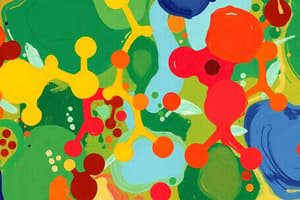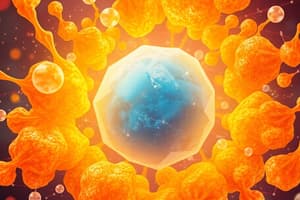Podcast
Questions and Answers
What is the general chemical formula of monosaccharides?
What is the general chemical formula of monosaccharides?
- Cn(H2O)n+1
- CnH2On
- Cn(H2O)n-1 (correct)
- CH2O
Which category of carbohydrates is known as the fundamental units of carbohydrates?
Which category of carbohydrates is known as the fundamental units of carbohydrates?
- Disaccharides
- Polysaccharides
- Monosaccharides (correct)
- Oligosaccharides
Which of the following is a common disaccharide composed of glucose and fructose?
Which of the following is a common disaccharide composed of glucose and fructose?
- Maltose
- Lactose
- Sucrose (correct)
- Cellulose
What role do polysaccharides play in living organisms?
What role do polysaccharides play in living organisms?
Which polysaccharide is found in animals and serves as a glucose storage unit in the liver and muscles?
Which polysaccharide is found in animals and serves as a glucose storage unit in the liver and muscles?
What is the function of disaccharides in the body?
What is the function of disaccharides in the body?
What is the primary function of cellulose in plants?
What is the primary function of cellulose in plants?
Why do polysaccharides provide a more gradual increase in blood glucose levels compared to monosaccharides?
Why do polysaccharides provide a more gradual increase in blood glucose levels compared to monosaccharides?
What effect do insoluble fibers have in the intestines?
What effect do insoluble fibers have in the intestines?
Where is excess glucose stored when not immediately needed for energy?
Where is excess glucose stored when not immediately needed for energy?
What is the main role of carbohydrates in the body?
What is the main role of carbohydrates in the body?
How does the body access stored glycogen when energy is needed?
How does the body access stored glycogen when energy is needed?
Study Notes
Biomolecules: Carbohydrates - Exploring Their Structure and Function
Carbohydrates are an essential class of biomolecules, containing carbon (C), hydrogen (H), and oxygen (O) atoms. They play a vital role in our bodies as an energy source, contributing to the overall health of cells, tissues, and organisms. Carbohydrates are organized into three main categories: monosaccharides, disaccharides, and polysaccharides, each with unique structures and functions.
Monosaccharides
Monosaccharides, or simple sugars, are the fundamental units of carbohydrates. They have a general chemical formula of Cn(H2O)n-1, where n ranges from 3 to 7. Glucose, fructose, and galactose are common monosaccharides that serve as the building blocks of more complex carbohydrates.
Disaccharides
Disaccharides are formed when two monosaccharides bond, creating a unit with a slightly more complex structure. Common disaccharides include sucrose (glucose + fructose), lactose (glucose + galactose), and maltose (glucose + glucose). Disaccharides are more easily digested and provide a quick source of energy to the body.
Polysaccharides
Polysaccharides are long chains of monosaccharides linked together by glycosidic bonds. They play a central role in energy storage and structural support within living organisms. Starch, a polysaccharide found in plants, stores excess glucose. Glycogen, a polysaccharide found in animals, serves as a glucose storage unit in the liver and muscles. Cellulose, a structural polysaccharide in plants, provides support and rigidity. Polysaccharides take longer to digest and therefore provide a more gradual increase in blood glucose levels.
Fiber
Fiber is a non-digestible complex carbohydrate that aids in healthy bacterial growth in the colon and promotes regular bowel movements. Insoluble fibers swell in the intestines, softening and bulking stool, while soluble fibers help decrease blood cholesterol and LDL levels.
Energy and Blood Sugar Control
Carbohydrates are a primary source of energy for the body, as they can be broken down into glucose molecules. Excess glucose not immediately required for energy is stored in the liver and muscles as glycogen. When energy is needed, the body breaks down glycogen into glucose, which is then released into the bloodstream to be used by cells.
Summary
Carbohydrates are essential biomolecules, providing energy, structural support, and other functions within living organisms. Their structures range from simple monosaccharides to more complex polysaccharides. Understanding carbohydrates' chemistry and function is vital to appreciating their important roles in human health and nutrition.
Studying That Suits You
Use AI to generate personalized quizzes and flashcards to suit your learning preferences.
Description
Test your knowledge on the structure and function of carbohydrates, essential biomolecules containing carbon, hydrogen, and oxygen atoms. Explore the different types of carbohydrates such as monosaccharides, disaccharides, and polysaccharides, their roles in energy storage, structural support, and blood sugar control.




